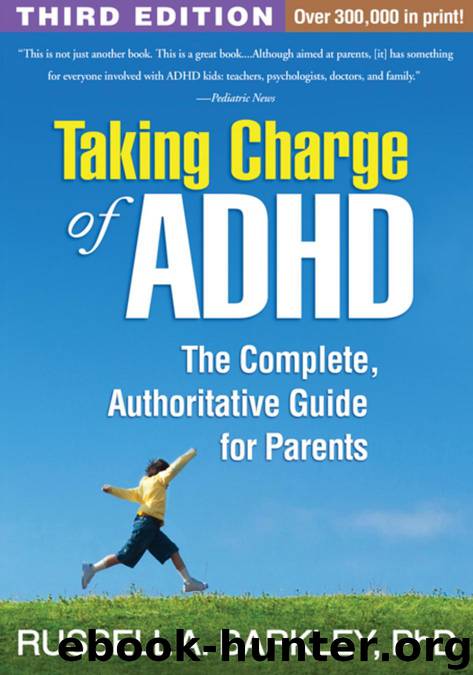Taking Charge of ADHD, Third Edition: The Complete, Authoritative Guide for Parents by Russell A. Barkley

Author:Russell A. Barkley
Language: eng
Format: mobi
Publisher: The Guilford Press
Published: 2013-01-25T17:33:50+00:00
169
170
TAKING CHARGE
of that stress. They in fact mistake one for the other and believe they need to eliminate the feelings of tension, irritability, depression and sadness, the fatigue, and the headaches, rather than the events that are precipitating them. Granted, there are
stressful events that can’t be avoided—more of them for you than for parents of children without ADHD. For these you will have to resort to stress reduction techniques such as formal relaxation methods, meditation, exercise, perhaps even medication in extreme cases. But in other cases—and you might be surprised by how many—you
can identify and avoid or at least reduce the source of the stress and head it off. Try this simple method:
1. When you have some quiet time, sit down with paper and pencil and think back
over the times in the last few weeks when you felt stress reactions: irritability, anger, hostility, anxiety, or depression. Then list the stressors—not how you felt, but the events that immediately preceded each stress reaction. What was it about that situation that you think may have precipitated your stress response? What did your child or someone else do that elicited this negative reaction from you? What did others do to your child? What might your spouse have done? What event came up that made you
feel this way? Leave a few blank lines after each stressor you identify.
2. Now look closely at the first event. What could you have done to avoid or
eliminate that event or problem? Did your reaction worsen the situation? Would any of Dr. Covey’s seven principles (see the Introduction) have helped you eliminate the stressor? Or would any of the 14 principles for raising a child with ADHD (see Chapter 9) have helped you avoid the situation? Can you see how any of these principles might help you eliminate or avoid this stressor the next time around? Or can you simply
plan to avoid the stressful event or person altogether? Write down at least one coping method after each of the stress events listed.
3. Now focus on one (or at most two) of these stressors and resolve either to
avoid the stressor in the future or, if it is unavoidable, to use your coping method the next time the event arises. Close your eyes and visualize yourself responding differently and more effectively in just that situation.
4. Remind yourself of your plan by posting small notes to yourself around your
home and work space.
5. Take a few minutes each day to practice visualizing your use of this new action plan. This practice will fortify your confidence that you can in fact head off the source of stress when it threatens to rise again.
6. Once your confidence has been built up or you have actually tried the new
plan, move on to another stressor or two. Work on only one or two stressors at a time until you’ve mastered or eliminated them; then move on to one or two more. Success here comes in small steps as you deal with just one or two stressors at a time, not by trying to deal with all of them at once.
Download
This site does not store any files on its server. We only index and link to content provided by other sites. Please contact the content providers to delete copyright contents if any and email us, we'll remove relevant links or contents immediately.
Should I Stay or Should I Go? by Ramani Durvasula(7435)
Why We Sleep: Unlocking the Power of Sleep and Dreams by Matthew Walker(6362)
Fear by Osho(4496)
Flow by Mihaly Csikszentmihalyi(4493)
Why We Sleep by Matthew Walker(4193)
Rising Strong by Brene Brown(4193)
How to Change Your Mind by Michael Pollan(4115)
Too Much and Not the Mood by Durga Chew-Bose(4096)
The Hacking of the American Mind by Robert H. Lustig(4092)
Lost Connections by Johann Hari(3927)
He's Just Not That Into You by Greg Behrendt & Liz Tuccillo(3719)
Evolve Your Brain by Joe Dispenza(3506)
The Courage to Be Disliked by Ichiro Kishimi & Fumitake Koga(3262)
Crazy Is My Superpower by A.J. Mendez Brooks(3207)
What If This Were Enough? by Heather Havrilesky(3199)
Resisting Happiness by Matthew Kelly(3197)
Descartes' Error by Antonio Damasio(3167)
The Book of Human Emotions by Tiffany Watt Smith(3145)
In Cold Blood by Truman Capote(3140)
